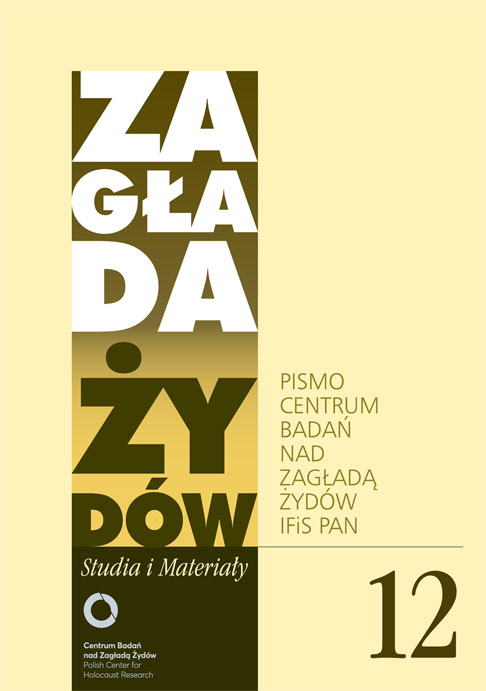Frankenstein w warszawskim getcie. Historia i legenda
Zagłada Żydów. Studia i Materiały, Nr 12 (2016), Strony: 187-208
Data zgłoszenia: 2020-10-19Data publikacji: 2016-11-30
 https://doi.org/10.32927/ZZSiM.414
https://doi.org/10.32927/ZZSiM.414
Abstrakt
The article deals with one exceptionally violent German perpetrator who was part of the occupation force in Warsaw during the Second World War. Inside the Ghetto he maltreated and killed a large number of women, children and men for his own personal pleasure. He did this to such an extensive degree that the population perceived him as monstrous being that was given the nickname „Frankenstein”. The article is mainly based on statements in juridical investigations, from the victim as well as from the perpetrator perspective, supplemented with some selected additional sources. Firstly the source corpus will be evaluated, to work out how these historical sources can be used to shed light on „Frankenstein”. This will be followed by an analysis of the actual identity of this perpetrator. It will be shown that he was, contrary to common belief, not necessarily the SS-Rottenführer Josef Blösche but more likely a member of the German Police Battalion 61. In the end the question will be also raised of how it was possible – despite all rules and regulations – that ghetto guards like him behaved like a marauding soldiery.
Słowa kluczowe
getto warszawskie , Zagłada , policja umundurowana , zbrodnie okupacyjne , warty w getcie , batalion policyjny , sprawca , przemoc , strach , terror , życie w getcie
Licencja
Prawa autorskie (c) 2016 Autor & "Zagłada Żydów. Studia i Materiały"

Utwór dostępny jest na licencji Creative Commons Uznanie autorstwa 4.0 Międzynarodowe.
https://creativecommons.org/licenses/by/4.0
Podobne artykuły
- Janusz Marszalec, Morderstwo na Makowieckich i Widerszalu. Stara sprawa, nowe pytania, nowe wątpliwości. , Zagłada Żydów. Studia i Materiały: Nr 2 (2006)
- Bożena Szaynok, Gross Jan Tomasz, Strach Fear. Anti-Semitism In Poland after Auschwitz, Random House, New York 2006 , Zagłada Żydów. Studia i Materiały: Nr 2 (2006)
- Agnieszka Haska, „Proszę Pana Ministra o energiczną interwencję”. Aleksander Ładoś (1891–1963) i ratowanie Żydów przez Poselstwo RP w Bernie , Zagłada Żydów. Studia i Materiały: Nr 11 (2015)
- Karolina Panz, Agnieszka Wierzcholska, Wspomnienia i kamienie. Życie i śmierć polsko-żydowskiego miasta Tarnów 1918–1956 , Zagłada Żydów. Studia i Materiały: Nr 20 (2024)
- Małgorzata Melchior, TEC Nechama, Resilience and Courage. Women, Men, and the Holocaust , Zagłada Żydów. Studia i Materiały: Nr 2 (2006)
- Jerzy Giebułtowski, Dzieje jednej faktury. Glosa do przypisu, czyli Central Park Heinricha Himmlera , Zagłada Żydów. Studia i Materiały: Nr 12 (2016)
- Marta Tomczok, Demon pojednania. Dyskurs o współczesnych Sprawiedliwych w powieści popularnej , Zagłada Żydów. Studia i Materiały: Nr 12 (2016)
- Piotr Rypson, Album rysunków Teofili Langnas-Reich w Archiwum Ringelbluma , Zagłada Żydów. Studia i Materiały: Nr 18 (2022)
- Mateusz Florczak, Saul Friedländer, Dokąd prowadzi pamięć. Moje życie, tłum. Michał Romanek, Kraków: Wydawnictwo Literackie, 2017, 366 s. , Zagłada Żydów. Studia i Materiały: Nr 14 (2018)
- Dan Michman, Społeczeństwo holenderskie i los Żydów: skomplikowana historia , Zagłada Żydów. Studia i Materiały: Nr 12 (2016)
<< < 1 2 3 4 5 6 7 8 9 10 11 12 13 14 15 16 17 18 19 20 21 22 23 24 25 26 27 28 29 30 31 32 33 34 35 36 37 38 39 40 41 42 43 44 45 > >>
Możesz również Rozpocznij zaawansowane wyszukiwanie podobieństw dla tego artykułu.
 English
English
 Język Polski
Język Polski








